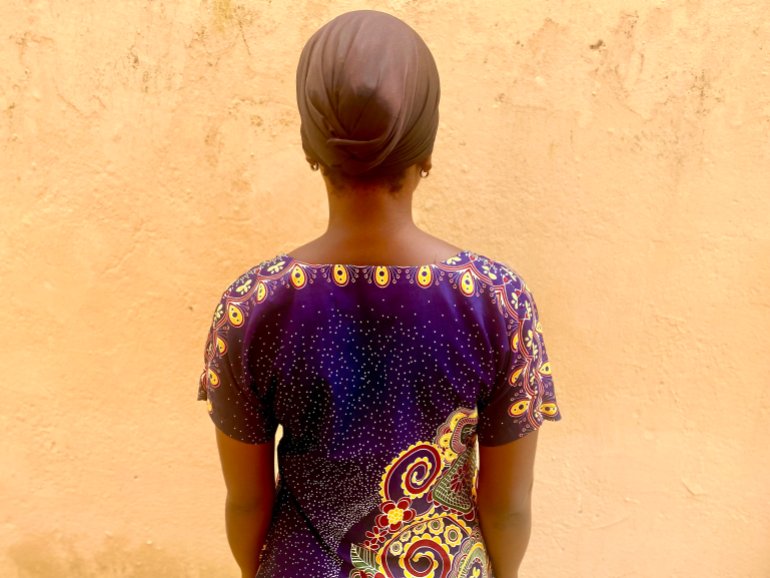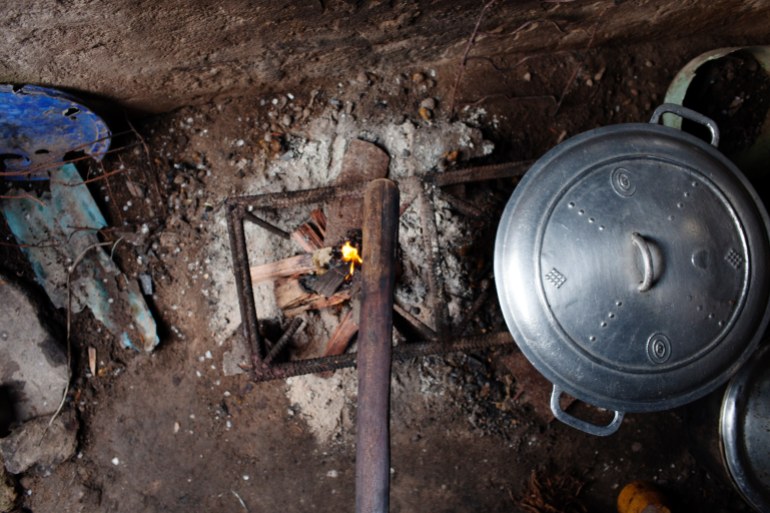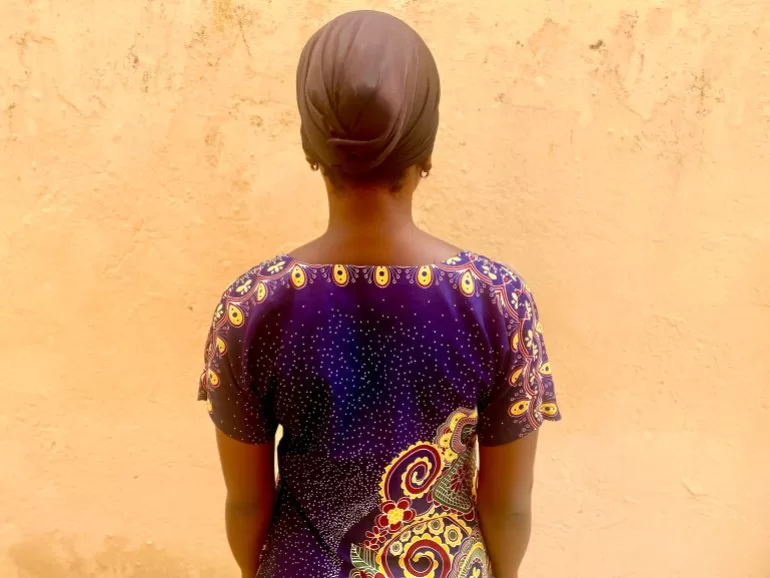Abuja, Nigeria – When children turn 10, their first double-digit milestone is usually a time of excitement. But not for Elizabeth John, who could only feel dread about what was to come.
A day after her 10th birthday, three older women held her legs down firmly as her mother pressed a burning hot pestle against her still-developing breasts, unyielding even as the child screamed in pain.
Nearly two decades later, the 27-year-old Cameroonian refugee who grew up in Nigeria’s Cross River State vividly remembers that day – as she grapples with the years of damage the ordeal inflicted.
John said her life changed after her mother forced her to undergo breast ironing in an attempt to shield her from sexual abuse.
Breast ironing, or “breast flattening”, is a cultural practice whereby young girls’ breasts are ironed or pounded down with brutal or heated objects to delay their development or disguise the onset of puberty, according to the Africa Health Organization.
The AHO says communities who practise breast ironing believe it will make girls less attractive to men, thus protecting them from harassment, rape, abduction, and early forced marriage, and also keeping them in school.
However, health bodies and rights groups say it is a form of physical mutilation that harms a child’s social and psychological wellbeing and contributes to the high school dropout rate among girls who suffer from it.
The United Nations (UN) says breast ironing affects some 3.8 million women in Africa and is one of the five most under-reported crimes related to gender-based violence.
Some 25 to 50 percent of girls in countries like Cameroon and certain parts of Nigeria are affected by the practice, according to data from the journal, Annals of Medical Research and Practice.
Done in secret
In John’s home community in Cross River State in southern Nigeria, the procedure is culturally imposed on most girls and typically performed by their mothers or other maternal figures.
For years after her breasts were ironed, John suffered from pain. Her breasts developed unevenly, and the muscles are still weak and saggy today.
At age 19, the pain was so bad that she had trouble sleeping, she said. Despite visiting doctors, her family did not believe breast ironing was the cause, adhering to their cultural beliefs.
“Before I married, I would buy painkillers for the breast pain, but it worsened after marriage [and pregnancy] when I was trying to breastfeed my child,” she told Al Jazeera.

In 2021, as she was about to give birth, a doctor explained that breast ironing had damaged her glandular tissue, which would make breastfeeding difficult, and suggested a medical procedure that could help her.
“After the doctor told me that the ironed breasts might affect me during childbirth, my husband and I couldn’t afford the treatment, which was $5,700,” she lamented. “I am jobless, and my husband works in furniture,” she explained.
After giving birth, she struggled to breastfeed correctly. The doctor recommended using formula, but the couple could not afford it.
They lost the baby when he was four months old.
Ushakuma Michael Amineka, a gynaecologist at the Benue State Teaching Hospital and the second vice president of the Nigeria Medical Association, explained that breast ironing can leave long-term effects.
“The immediate consequences can include pain because the breast is very soft tissue. If compressed, it can cause pain and even distort the normal anatomy of the breast tissue,” he told Al Jazeera. “Long-term consequences could include difficulties with lactation, as it can destroy breast tissue and lead to infections, causing long-term pain and reduced breast milk production.”
According to 2021 research published by the United States’ National Institutes of Health (NIH), the harmful practice is typically carried out by close female relatives, and sometimes with the help of traditional midwives. It is maintained in secret by female members of the family and community, and typically hidden from men.
Traditional and household tools are usually used to perform the procedure, including grinding stones, cast iron, coconut shells, calabashes, hammers, sticks or spatulas. Additionally, it can involve tightly wrapping the breasts with a belt or cloth, the NIH said.
The lack of good data and empirical studies on breast ironing has also limited a broader understanding of the practice and its prevalence, NIH added.
Longstanding tradition
“This cultural practice is horrible and inhuman,” David Godswill, a Nigerian human rights activist, told Al Jazeera.
Those who practise it “believe that if breasts develop, they will attract men”, he said, but he emphasised that the procedure is just cruel.
The effects can be traumatic, causing women and girls physical pain and shame about their bodies.
“It’s evil what they do to women’s breasts, and many have suffered health issues because of it,” he said.

For John, the health effects of breast ironing have caused her years of personal pain and struggle. Now, living in Gbagyi, an Indigenous community in Nigeria’s capital Abuja, every day is a reminder of her childhood trauma.
Breast ironing is a longstanding tradition in Gbagyi and many young girls in the community have had their breasts ironed, John told Al Jazeera.
When she tried to warn their mothers about the health risks based on her own experience, they did not believe her and thought she wanted to encourage intimacy between men and younger girls.
Conversations Al Jazeera had with seven local women in Gbagyi revealed that nearly all had experienced breast ironing. They also pushed their daughters into having the procedure to protect them from male attention and sexual abuse. Many said their mothers and grandmothers also underwent this practice.
One woman, Roseline Desmond, told Al Jazeera that when a group came three years ago to raise awareness about the health implications of breast ironing, some women promised to stop while others remained unconvinced.
“In this community, some midwives even perform breast ironing as a source of income, similar to female genital mutilation. After being educated about its implications, I and some other women stopped helping residents iron their daughters’ breasts and ceased the practice within the community,” she said.
John is determined to stop the practice in her own family. “My daughters will never experience the pain I endure from breast ironing,” she said.
One in three
Breast ironing – like other harmful traditional practices – is considered a violation of human, child and gender rights, as set out in international treaties such as the UN Convention on the Elimination of All Forms of Discrimination Against Women, the UN Convention on the Rights of the Child, and the African Charter on the Rights and Welfare of the Child, the NIH noted.
In Nigeria, practices such as female genital mutilation, breast ironing and forced marriages are also criminal offences under the Violence Against Persons and Prohibition (VAPP) Act. The VAPP Act stipulates: “A person who carries out harmful traditional practices on another commits an offence and is liable on conviction to a term of imprisonment not exceeding four years or to a fine not exceeding N500,000.00 [$300] or both.”
Olanike Timipa-Uge is the executive director of Teenage Network, a feminist-led nonprofit that facilitates access to education and health for adolescents and collaborates with Action Aid Nigeria to combat harmful sociocultural norms that promote violence against women and girls.
“One of our key focuses is breast ironing in Nigeria’s capital, Abuja,” he said. “A baseline assessment in various communities within the Federal Capital Territory (FCT) revealed that one in three adolescent girls in these communities had experienced breast ironing.”
Timipa-Uge explained that while breast ironing is prevalent beyond the FCT and widely practised throughout Nigeria, the reporting rate remains significantly low because of the lack of awareness. Her organisation has engaged in extensive outreach with adolescent girls, many from areas like Niger State, who have shared their experiences with breast ironing.
“We conduct community outreach and advocacy programmes to educate parents about the severe health consequences of breast ironing,” Timipa-Uge said. “We emphasise how this practice damages the girls’ futures and hampers their aspirations.
He added that they also sent numerous letters to the federal Ministry of Women Affairs, “calling for the abolition of this harmful practice”, to which they received no response.
In Gbagyi, John told Al Jazeera she now faces pressure from her husband’s family to have another baby after the couple lost their first child when she could not breastfeed him properly. But only she and her husband know the real reason and the ordeal they experienced.
“I have been silently battling pain in my breasts. The doctor told us we need over N15 million ($5,400) for treatment before the pain stops and my breasts can be fit for breastfeeding,” she said.
Since her husband lost his job last year, it has been difficult for them to afford food, often having to beg for money, so an expensive medical procedure is out of the question.
“I don’t know when the pain will stop. It keeps hurting my breasts,” John said. “And since we don’t have money for treatment, only God knows.”
